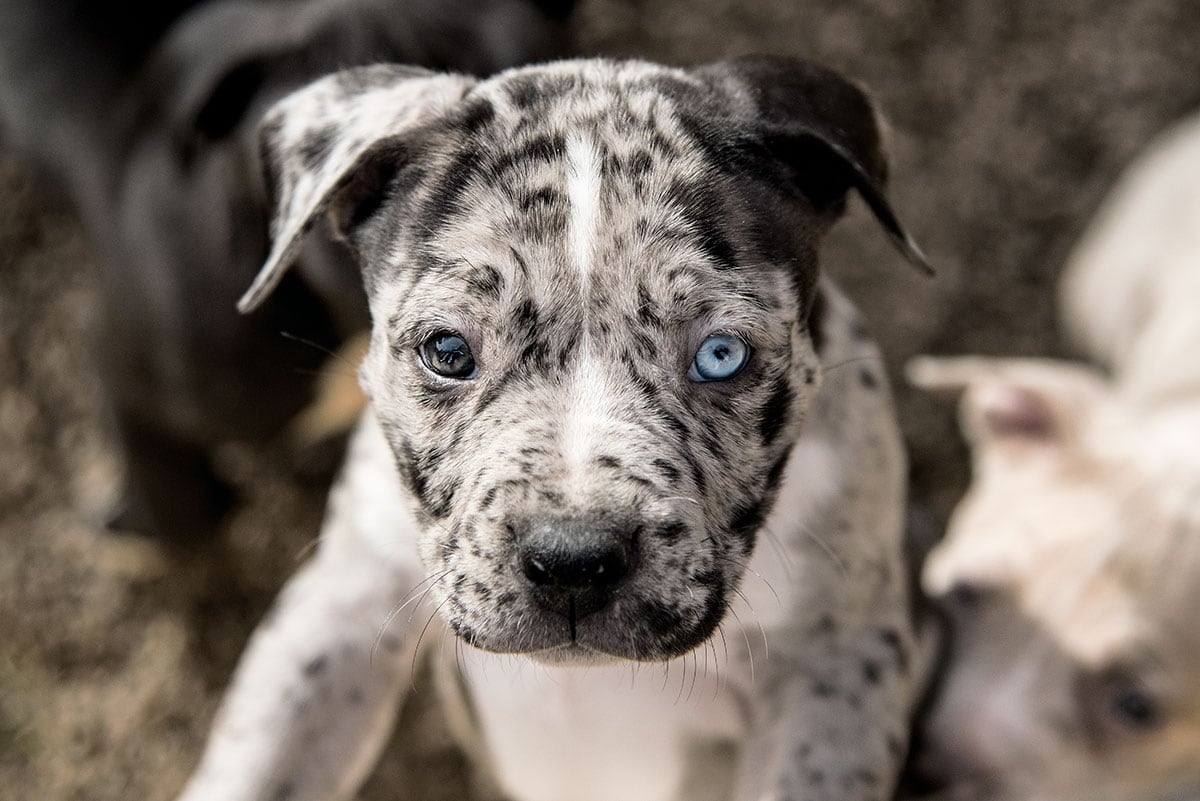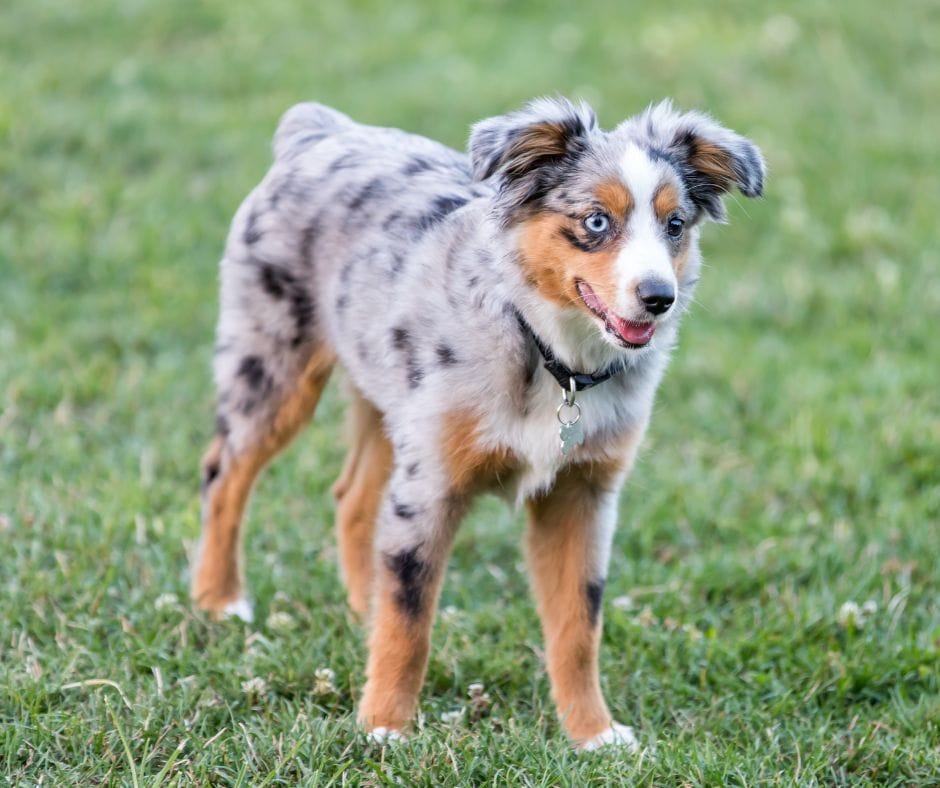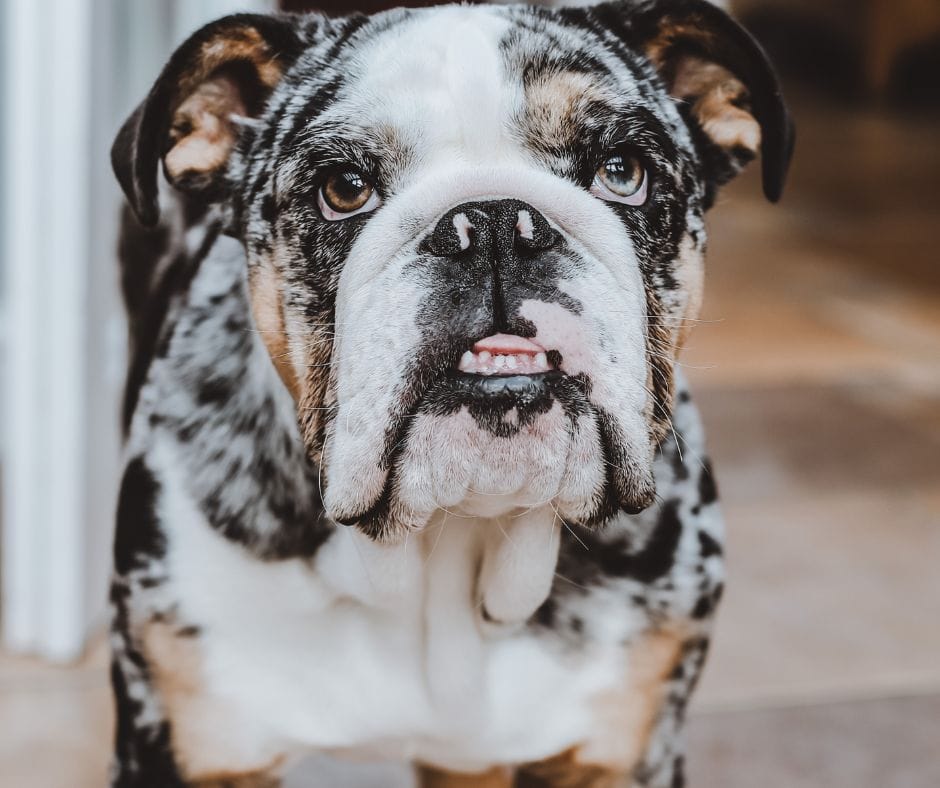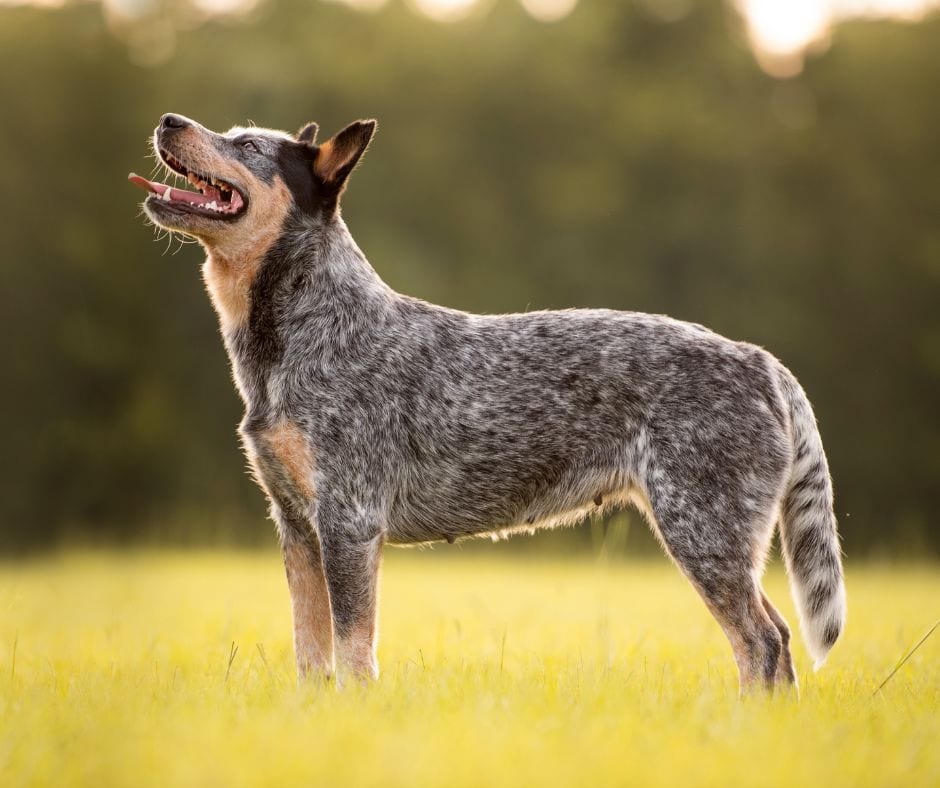Merle, dapple, adorable — whatever your name for it, there’s no mistaking this eye-catching coat pattern.
Generally characterized by a coat full of dots and dark-colored swirls on top of a lighter base color, merle patterns are an in-demand look in the dog world.
Merle dog breeds come in a variety of slightly different looks, including the joyful mix of blue, black, and white commonly seen on Australian shepherds, as well as the smoky look popular among pit bull fans.
We’re going to explain some things about the merle gene and how it affects dogs first, but feel free to jump down to our list of merle dog breeds if you just want to see some of these great doggos!
Merle Dog Breeds: Key Takeaways
- The merle gene is found in a number of dog breeds. Some of the most notable include the Australian shepherd, Great Dane, and Chihuahua.
- When present, the merle gene causes a number of different changes in a dog. This includes obvious things like a change in coat color, as well as things that aren’t visible, such as changes in the dog’s eyes.
- Dogs who inherit two copies of the merle gene typically suffer serious health problems. This means that it is important for dog breeders to avoid breeding merle dogs with other merle dogs.
Magnetic Merle: What Is a Merle Dog?

The merle gene is more than just a coat pattern, with the gene responsible for affecting everything from skin color to hearing.
One merle pup may have a cute, multi-colored nose and toe beans with a relatively plain coat color, while another might have different eye colors and a magnificent coat of browns and grays with a solid nose. You can also find dilute merles with a lighter mix of blues or reds.
With so many incredible looks found with the merle coat color, it’s little wonder why people can’t get enough of these stunning sniffers.
But while the look does have obvious appeal, it also has drawbacks.
Merles should never be bred together as serious issues may arise in those pups who inherit two copies of the merle gene.
Typically called double merles, these pups have a high prevalence of deafness and serious eye problems. The double merle’s predominantly white coat is also extremely sensitive to sunlight.
Spotting a merle isn’t always easy, either.
There are so-called cryptic merles in the gene pool that don’t have the classic merle coat color, making genetic testing a must before merle breeding to avoid problems. This is critical in breeds known to carry the gene, such as Australian shepherds, border collies, and several other collie breeds.
Breed clubs and fanciers of merle dog breeds advocate strongly to protect future pups from the negative health consequences seen in double merles.
Merle Genetics 101

To be born with the merle gene, a puppy must inherit one copy of the merle allele (M) and one copy of the non-merle allele (m).
Mere is an incompletely-dominant (sometimes called semi-dominant) gene, meaning only one copy is needed between the parents to be passed on — if a dog has the gene, it is a merle (though it isn’t always visibly obvious).
By contrast, a recessive gene requires two copies (one from each parent) to be passed on.
Spotting a merle dog genetically is done by locating the Mm combination or genotype. A non-merle dog has the mm genotype, and a double merle has the MM genotype.
Merle Dog Breeds Vs. Lethal Whites

“Lethal whites” is a term used in horses, specifically the American paint horse.
As the name implies, it’s a condition that results in a foal’s death shortly after birth due to severe birth defects. Sadly, this label is often misused and applied to double-merle canines.
Like double merle dogs, a lethal white horse must inherit a copy of one specific gene from each parent, but this is where the similarities end.
Lethal whites inherit a gene mutation from each parent that causes severe malformations of the colon that aren’t compatible with life, while a double-merle litter of puppies almost always survives.
Owning a Double Merle Dog

A double-merle dog may have an auditory impairment or eye issues, but he can still lead a full life with proper care and guidance.
Blind puppies and those experiencing deafness learn to navigate the world just fine, though they should be placed in homes capable of giving them the extra love and patience needed.
That said, a double-merle dog should never be bred, nor should anyone set out to purposely create them.
Properly rehoming an entire litter of dogs with special needs to quality forever homes is difficult, and the potential negative health consequences (particularly surrounding eye issues) make intentionally breeding them irresponsible and inhumane.
A Multitude of Merle Dog Breeds
Now that you have the scoop on all things merle, let’s check out breeds that may carry the gene.
1. Australian Shepherd

The most notable of merle dog breeds is the Australian shepherd or Aussie, a lovable, high-energy herding dog who dominates the agility scene with his bounce and enthusiasm. He’s a solid pick for families, but he needs to know that he’s supposed to herd sheep, not kiddos.
The Aussie requires frequent exercise and mental stimulation to prevent destructive behavior and mischief.
2. Chihuahua

Say hello to this adorable little friend. Usually referred to as dapple in the breed, merle is also found in the world’s smallest doggo. A pint-sized pup with a big-dog attitude, chihuahuas make wonderful lap dogs and excellent watchdogs.
There are several different types of Chihuahua, but they’re all lovebugs to trusted friends (though they can be wary or snippy with strangers).
3. Cardigan Welsh Corgi

Easily recognized as the corgi with a tail, the merle Cardigan Welsh corgi is in high demand. A boisterous pup affectionately called Cardis (not to be confused with the rapper, though they do have a cool bark), this pupper got his start in herding, believe it or not.
The Cardi is an excellent candidate for dog agility sports, though special care should be taken during exercise because of his long, low build.
4. Shetland Sheepdog

What a cute floof! While most of us usually think of the traditional sable sheltie, blue merle pups also appear. A high-energy honey with a strong desire to please, shelties excel in obedience and agility competitions.
That long, flowing coat does require some heavy-duty grooming, however, so take that into account before scooping one up.
5. Catahoula Leopard Dog

An all-American hunk with strength and a thirst for adventure, the Catahoula is known for his striking good looks, including numerous shades of merle, like red, blue, white, and yellow. Bred as a hunting dog, Catahoulas are excellent jogging companions.
Catahoulas require early socialization and training, however, to avoid serious behavioral problems, and they aren’t recommended for first-time dog owners.
6. Dachshund

Like Chihuahuas, the merle coloring is referred to as dapple in dachshunds. A handsome hound with a big personality despite his stumpy legs, the dachshund is a great companion.
His build doesn’t allow him to be a traditional athlete, but that doesn’t stop him from being the obedience class clown.
7. Collie

Both rough and smooth collies come in merle and a wide range of other colors and patterns.
Known for his long, expressive face and flopped ears, he’s one handsome doggo, though his grooming needs vary by his coat, with the rough variety requiring frequent combing to avoid tangles while the smooth collie needs less to remove shedding hair.
These canine athletes are a fixture on the agility circuit and make incredible running and jogging buddies, but regular exercise is a must to keep naughtiness at bay.
8. Koolie

A relatively rare cutie from Down Under, the Koolie is a scrappy merle breed who isn’t afraid of a little fun in the sun. He got his start in herding livestock, so he has as much energy and drive as the Energizer Bunny, making him an all-star athlete.
Like similar breeds, the Koolie must stay busy to prevent destructive behavior and isn’t a good breed for first-time dog owners.
9. Pit Bull

Pitties come in all sorts of colors — including merle, though UKC standards don’t recognize it.
He’s an active breed that needs a great deal of exercise to stay out of trouble, but he’ll happily transform into a house hippo to snooze on your sofa between runs.
A holder of the dynamic terrier temperament, merle pit bulls need early socialization and training to prevent animal aggression and curb chasing instincts.
10. Beauceron

Coming in several colors and patterns, including merle, this French herding dog is a working breed to the bone with a background in police work. He lives to please his owner and does best in an environment where he’s always busy.
The Beauceron is a natural guard dog breed and is reserved with strangers, so early training and socialization are required.
11. Border Collie

Like the Aussie, the Border collie is a regular on the agility scene. He’s another shining star in looks, too, as the pupper is one of the most common merle dog breeds.
Because he’s one of the smartest dog breeds, as well as an impressive athlete, the border collie needs daily exercise and mental stimulation to remain happy and non-destructive.
12. Great Dane
A gargantuan merle carrier, the Great Dane is the largest dog breed with an even bigger heart. He started as a hunting dog in Germany, though today, he’s more likely to be hunting treats on your countertops.
He’s very much a gentle giant, and while he needs regular exercise to keep trim, avoid overdoing it to prevent joint issues.
13. Pomeranian

A tiny spitz with a foxy personality, the Pomeranian is a beloved companion and surprisingly effective watchdog with a dense coat that comes in merle and a variety of colors and combos. He’s naturally feisty and alert, making him unafraid of sounding the alarm at the slightest noise.
His dynamic ‘do needs serious upkeep to stay stunning, including regular combing to prevent mats.
14. American Staffordshire Terrier
While merle isn’t listed in the Am Staff’s AKC breed standard, this powerful pup sometimes pops up with the pattern. His short coat is a breeze to maintain, but he has some major exercise requirements to burn off his mountains of energy.
He isn’t recommended for first-time dog owners, as his terrier temperament can be challenging to train.
15. Mudi

Hailing from Hungary, this petite herder has a dense, medium-length coat that can be merle or a wide range of colors, including black, white, and gray. He’s a rare breed around the world, with most remaining in his homeland, where he’s a prized companion.
The mudi is a worker at heart and needs daily exercise to feel his best, with his natural athleticism helping him excel in doggy sports like agility competitions and flyball.
16. Bergamasco Sheepdog
Merle isn’t listed in the Bergamasco’s breed standard, but it’s sometimes seen in this cord-coated cutie from Italy. Matting the coat into its corded appearance takes time, but once completed, he only needs a bath a few times a year and zero brushing.
This working woof requires moderate daily exercise and patience during training, as he has an infamous independent streak that can be a handful.
17. Cocker Spaniel
Merle is occasionally seen in cockers, though it isn’t part of the breed standard. His long, flowing coat requires a lot of care if kept long, but you can opt for a shorter clip every few weeks for easier everyday upkeep.
This sweet-natured sniffer is playful and active, making him a good choice for those interested in a smaller, city-friendly dog with a pep in his step.
18. Pyrenean Shepherd

As intelligent as he is mischievous, the Pyrenean shepherd is a herding dog with a mind of his own. His coat comes in rough and smooth varieties, with various solid colors and patterns like merle and brindle meeting his AKC standard.
Pyrenean shepherds are affectionate floofs with high energy levels that mesh well with family life as long you exercise your pup daily and offer lots of attention.
19. Miniature American Shepherd

A doppelganger of Australian shepherds, this short-statured pup has a playful, affectionate nature that’s perfect for families. His long coat comes in a few stunning shades, including black, red, blue merle, and red merle, and it requires frequent brushing to avoid tangles.
While on the smaller side, he still needs daily exercise to keep him content and is the perfect sport dog in a travel-friendly size.
20. French Bulldog

The AKC standard for Frenchies does not recognize merle, but it’s popping up in pet circles. This breed’s playful ways and affectionate nature have led to a meteoric rise in popularity.
The Frenchie is one of the most expensive dogs to buy and care for, as he’s prone to a number of serious health issues.
21. Bulldog

Beloved for his boulder-like build and clownish nature, this mighty meatball doesn’t have merle in his official AKC standard, but the color pattern is showing up more often in the breed. His short hair is easy to care for, though you’ll need to frequently clean and thoroughly dry his skin folds to prevent irritation.
Bulldogs are incredible family dogs, but training one can be a challenge, as they’re as “bull-headed” as the moniker implies.
Markings Sometimes Confused With Merle
Canine coat terminology is full of patterns and shades, with merle just one of many looks in the dog world. Let’s dig into those most commonly mixed up with merles.
Harlequin

Harlequin is when a dog has a white base coat with black patches featuring irregular borders. This is somewhat cow-printed in appearance and can resemble black paint “splattered” on a doggo.
Great Danes are the most common harlequin dog breed, but Beaucerons also sport this stunning look at times.
Speckled or Ticked

This look features small “flecks” or spots of one color over another. These markings are much smaller than the spots of a Dalmatian, resembling more of a fine mist of color. German short-haired pointers and Australian cattle dogs are prime examples of breeds that are often speckled.
Brindle

Sometimes called “tiger-striped,” brindle dog coats consist of a solid base coat marked with darker or lighter stripes across his fur. Darker brindle pups usually have a black coat marbled with gold, brown, or tan, while lighter ones may be fawn with gray or black stripes.
Brindle is a common coat pattern in mastiffs and bully breeds.
Sable

A sable sniffer has black tips on his fur, giving him a darker look in certain areas of the body. If you were to brush his hair down, you’d notice fur closer to the body is lighter while the ends have a distinct dark pigment.
Sable is a common coat pattern in Pomeranians, collies, and Shetland sheepdogs.
Merle Dog Breeds: FAQ
Understanding the merle coat pattern can be tricky, as this cute and colorful look is somewhat uncommon in the dog world, leaving more questions than answers for some pet parents.
Check out the most common questions surrounding merle dog breeds below.
What breed of dog is a merle?
Merle is a gene found in dogs that may present with a colorful coat pattern, but it’s not a breed. It consists of swirled or mottled patches of blues, black, and white or various shades of red and white. Dogs can also carry the merle gene without showing the distinct coat pattern. A dog like this is called a “phantom merle” or “cryptic merle.”
Merle dog breeds are also famous for their eye colors, with some having bright blue ones while others are soulful brown. In some instances, they may even have different-colored eyes!
How much is a merle dog worth?
The price of a dog with a merle coat varies significantly by breed and lineage. For instance, a champion show dog or working-line pup will run more than a pet-quality pup. Proper genetic and health testing also increases puppy pricing to cover costs and is a hallmark of an ethical breeder of merle-coated canines (and all dogs, for that matter.)
A standard starting price point of merle puppies is about $500, but this can stretch over $2000, depending on the pup’s pedigree.
Do merle dogs have more health problems?
Dogs with the merle gene may be more likely to develop deafness and blindness. Their skin and noses can be more prone to sunburns and skin cancer, particularly dogs with large white patches. Avoid prolonged sun exposure for dogs with sections of white coat, and apply a dog-safe sunblock or slip on a t-shirt to protect these delicate areas when necessary.
The greatest risk with merle dogs is double merles, meaning a dog who inherits the merle gene from both parents. These pups are most at-risk of serious eye issues and deafness. This makes genetic testing of all merle dog breeds before breeding critical. Always seek a breeder who practices safe, ethical merle breeding to ensure your puppy is as healthy as possible.
What dog breeds naturally carry the merle gene?
Common breeds that come in the merle coat pattern include the Australian shepherd, border collie, and Shetland sheepdog. These breeds officially list the merle pattern in their breed standard with the AKC or UKC, but other breeds occasionally have merles within their ranks despite being unrecognized, including American Staffordshire terriers, French bulldogs, and pit bulls.
Why are merle dog breeds more expensive?
Merle dog breeds are more expensive for a number of reasons. For one, genetic testing is needed in every merle breeding to prevent a double-merle litter. Secondly, breeders may charge pet owners a premium for such an in-demand coat color. This is sadly common in unethical breeders who may not do their due diligence to prevent double-merle puppies, choosing instead to market them as “exotic.”
What is a double merle dog?
A double merle dog inherits the merle gene from both parents, risking deafness and severe eye issues. Merle dogs should only be bred with non-merle dogs. A dog can carry the merle gene without having merle patterning, which is why genetic testing is so vital in breeds that can be merle to rule out phantom carriers.
Isn’t merle a majestic coloring? Do you own a merle pup? Tell us about your pooch in the comments below (or share photos via our uploader)! We’d love to hear about your merle fur baby.








6 Comments
September 19, 2021
Chihuahua, pitbull, and Pomeranians don’t have Merle coats if they do they’re badly bred and byb(back yard bred/breed) please don’t get the idea that they are natural Merle
September 20, 2021
Hey there, Frog.
It depends on what you mean by “natural.” We (people) have made all of 3,000-odd dog breeds what we want — it’s not as though we captured a herd of Chihuahuas from the wild and started a breeding program.
Also, we’d argue that displaying merle coat doesn’t necessarily imply poor breeding.
But thanks for sharing your thoughts!
April 22, 2021
A well detailed and useful article. Thank you for sharing,
it’s definitely going to help lots of people out there.
You always publish handy info, some of which I share
on Fb.
August 16, 2020
What type of dog is in the first picture??
August 17, 2020
That’s an Australian shepherd, Erin.
🙂
December 25, 2019
I have a blue Merle Pomsky and she is just an amazing pup. I can’t seem to post a pic here, but her name is Mia and she has her own Instagram @miapomsky907 and she just might be the cutest dog in Alaska :o)
Merry Christmas and cheers from Kodiak Island!!!